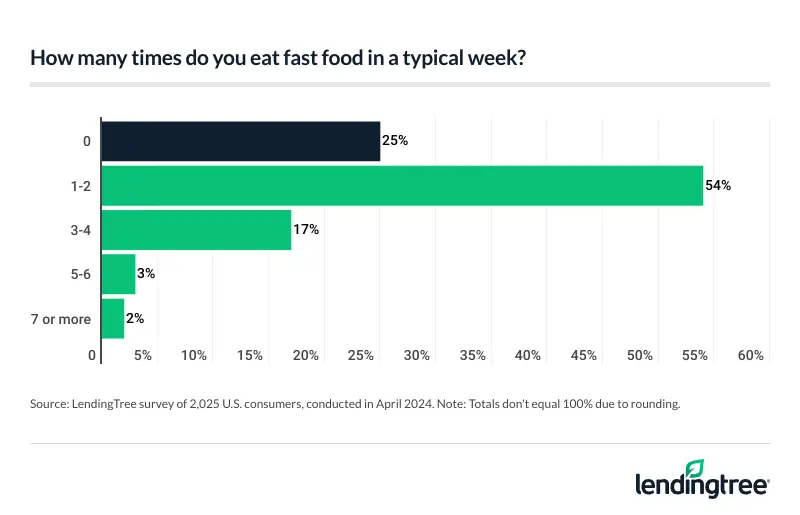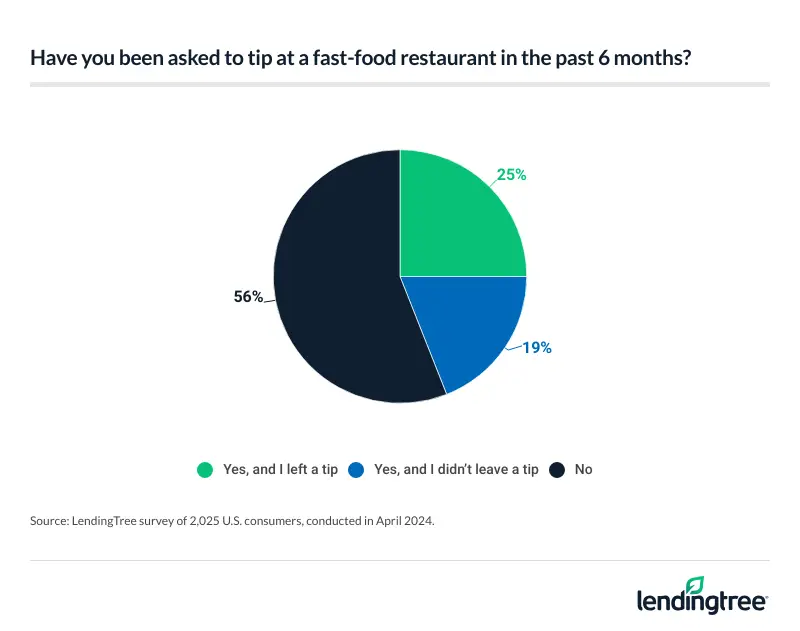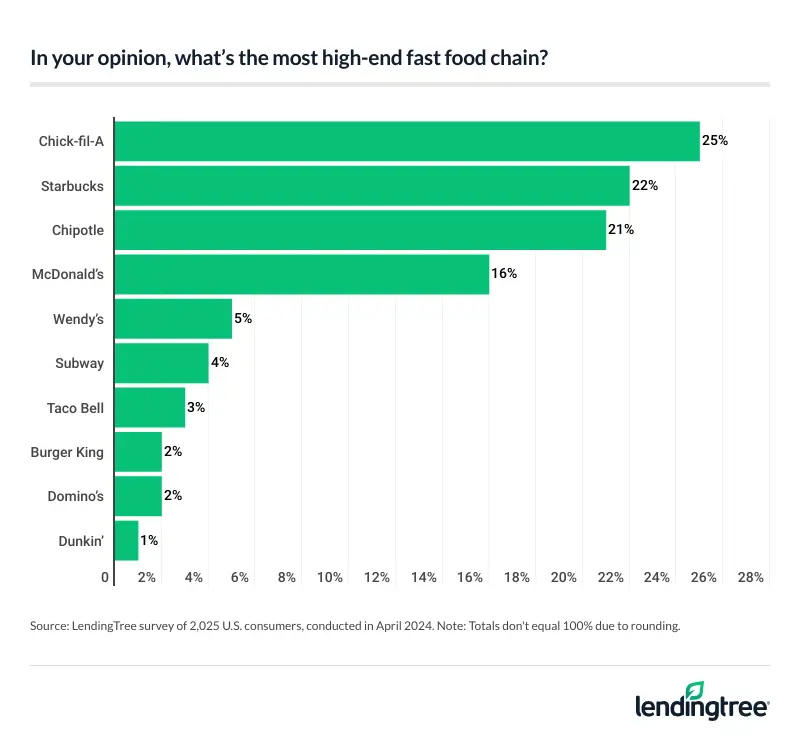Nearly 80% of Americans Say Fast Food Is Now a Luxury Because It’s Become So Expensive
Thanks to rising prices, most Americans now see fast food as a luxury and are eating it less often, according to a new LendingTree survey.
Rampant inflation has forced millions of Americans to reassess their spending habits. For many, that has meant fewer trips to the drive-thru for that burger, burrito or spicy chicken sandwich they love — and even a change in how they perceive fast food.
To learn more, LendingTree asked more than 2,000 American adults about their views and behaviors around fast food and how they’ve changed in the wake of seemingly everything getting more and more expensive.
Here’s what we found.
Key findings
- Americans love fast food, but costs are forcing them to curb their cravings. 3 in 4 Americans typically eat fast food at least once a week, but the majority (62%) say they’re eating it less due to rising prices. In fact, 65% of Americans have been shocked by the high price of a fast-food bill in the past six months.
- Are burgers the new Birkins? 78% of consumers view fast food as a luxury because it’s become increasingly expensive. Additionally, half of Americans say they view fast food as a luxury because they’re struggling financially. This is especially true among Americans who make less than $30,000 a year (71%), parents with young children (58%), Gen Zers (58%) and women (53%).
- Americans are opting for food at home. While 67% of Americans agree fast food should be cheaper than eating at home, 75% say this isn’t the case. Further, nearly half (46%) say fast-food restaurants cost similarly to their local sit-down restaurants, while 22% say fast food is more expensive. When asked about their go-to for an easy, inexpensive meal, 56% cite making food at home.
- Surge pricing and tipping leave a bad taste in consumers’ mouths. 78% of Americans are concerned about surge pricing at fast-food restaurants, but 72% admit they’d be more likely to eat fast food at off-hours if there was a discount. Additionally, 44% of Americans say they’ve been asked to tip on fast food in the past six months, and 43% of those asked refused to add gratuity.
- Not all fast-food chains are rated equally, but apps help to lure some customers to return for more. Americans rank Chick-fil-A as the most high-end fast-food chain (25%), followed by Starbucks (22%) and Chipotle (21%). Further, 46% of Americans use apps for fast-food establishments that entice them to visit more often.
Americans love fast food, but costs are forcing them to curb their cravings
For generations, fast food has been a quick, low-cost, convenient way for budget-watching Americans to feed their family on busy school nights, after a long day of work or even when no one feels like cooking but you don’t want to break the bank.
We know it isn’t the healthiest choice for us physically, but it could sometimes serve an important purpose financially for busy families living paycheck to paycheck and trying to make ends meet.
However, inflation is changing that. Most Americans (75%) still eat fast food at least once a week, but 62% of Americans say rising prices are forcing them to eat it less often.

Not surprisingly, the lower your household income, the more likely you are to say you’re eating less fast food because of rising prices, with 69% of those making less than $30,000 a year saying so. However, even among the highest-income Americans, more than half say they’re eating it less (52% of those earning $100,000 or more a year). Women are more likely than men to say so (65% versus 60%), while Gen Xers ages 44 to 59 are the most likely generation to say so (66%, compared with 62% of baby boomers ages 60 to 78 and millennials ages 28 to 43 and 54% of Gen Zers ages 18 to 27).
Nearly two-thirds (65%) of Americans say they’ve felt “sticker shock” or been surprised by the size of their bill at a fast-food restaurant in the past six months. Nearly 3 in 4 parents with kids younger than 18 (72%) say so.
Are burgers the new Birkins?
With so many people getting a side of sticker shock with their burger, fries and Coke combo, it shouldn’t be surprising that people’s views of fast food are changing. It’s becoming clearer and clearer that the days of occasionally using fast food as a cheap way to help make ends meet are long gone. Now, most Americans say it’s more likely to wreck your budget than to help you extend it. In other words, it has become a luxury.
We asked our respondents if they agreed with the following statement: “Fast food has gotten more expensive, and I now view it as a luxury.” Nearly 8 in 10 respondents (78%) say yes. That percentage hit 80% or higher among those making less than $30,000 a year (83%), parents with kids 18 or older (82%), Gen Xers (81%) and women and parents with kids younger than 18 (both at 80%).
We then asked people if they agreed with a slightly different statement: “Fast food is a luxury for me because I’m struggling financially.” Half of respondents agree with that, with lower-income Americans, parents of young children, Gen Zers and women leading the way.
While the first statement is more about looking at rising fast food prices in a vacuum, the second is about viewing fast food as a whole through the prism of their financial situation.
The results make clear, regardless of the context, that most Americans now see fast food as a luxury. That’s a new phenomenon. Yes, there have always been groups of Americans who might have viewed fast food that way because of their financial struggles. However, for the vast majority of Americans to feel that way seems like a significant cultural shift, and a troubling sign.
Americans are opting for food at home
Our survey found that 3 in 4 Americans think eating at home is cheaper than getting fast food. That’s not how they think things should be — 67% of Americans say fast food should be cheaper than eating at home — but it’s the reality facing millions today.
As a result, people are staying home. When asked for their go-to choice for an easy, inexpensive meal, 56% say they opt for making food at home. That’s twice as much as those who say fast food (28%).

Making food at home is the top choice for all age groups, but a closer look reveals significant differences, with older Americans being far more partial to cooking at home than their younger counterparts. Among baby boomers, 63% choose to make food at home, while just 20% opt for fast food. For Gen Xers, the percentages are 60% and 26%, while millennials are 53% and 32%. The biggest outlier is Gen Zers: Only 47% would make food at home, while 39% would opt for fast food.
Surge pricing and tipping leave a bad taste in consumers’ mouths
The impact of inflation on fast-food prices has been huge. Unfortunately, it isn’t the only factor bothering fast-food customers these days. Tipping and the specter of surge pricing — fast-food places raising their prices dynamically during peak times — are as well.
Of course, tipping is nothing new in much of the restaurant world, but fast food is different. We haven’t traditionally been asked to tip 20% when buying a Happy Meal for our kid. However, that’s changing at certain establishments. Much has been written about how technology has made it easier and easier for companies to ask for tips from their customers and how many companies are taking advantage of it to bring in extra revenue, sometimes to the annoyance of their customers. That’s spurred talk among millions of Americans of “tipping fatigue.”
Our survey is clear that tipping has come to fast-food restaurants, as 44% of respondents say they’d been asked to tip at a fast-food place in the past six months.

However, many Americans say no to these tip requests. We found that 43% of those who say they’ve been asked opted not to tip.
While tipping has certainly come to the world of fast food, surge pricing hasn’t yet — at least in a big way — but even the idea of it troubles many Americans. Nearly 8 in 10 respondents (78%) say surge pricing, in which people pay more during peak hours, is concerning. That disdain permeates most types of people, with little difference among the various demographics. One exception: Higher-income Americans are far more likely to be concerned about surge pricing than those at the other end of the income spectrum. In fact, 84% of those making $100,000 or more are concerned, versus 71% of those making less than $30,000.
Surge pricing became a topic of conversation in early 2024 after reports emerged that fast-food giant Wendy’s would introduce it at its stores. However, after a significant backlash from the public, Wendy’s attempted to clarify the situation.
“This was misconstrued in some media reports as an intent to raise prices when demand is highest at our restaurants,” Wendy’s spokeswoman Heidi Scheuer said in a statement to The Washington Post. “We have no plans to do that and would not raise prices when our customers are visiting us most.” She added: “Digital menu boards could allow us to change the menu offerings at different times of day and offer discounts and value offers to our customers more easily, particularly in the slower times of day.”
Where does that leave things? It’s unclear. However, we know from our survey that if surge pricing comes to the fast-food space, it won’t be very popular with the public.
Not all fast-food chains are rated equally
Even the most infrequent fast-food eater knows there can be vast differences among the various establishments. With that in mind, we asked respondents what they thought was the “most high-end” among the nation’s fast-food chains with the most U.S. sales. (Note: We left it up to respondents to define what high-end meant to them.)
Among the 10 options, there was a clear winner, three others that drew significant votes and six others that fell far short. While Starbucks (22%), Chipotle (21%) and, perhaps surprisingly, McDonald’s (16%) are among the most popular choices, Chick-fil-A (25%) wins the day.

There are generational differences. Gen Xers and millennials both choose Chick-fil-A, while baby boomers say Starbucks and Gen Zers say McDonald’s.
The least popular choice overall is Dunkin’. Just 1% of respondents say it’s the most high-end chain.
Apps help to lure some customers but can also keep costs down
Whatever their favorite fast-food place, Americans are acutely aware that it costs a good bit more to go there today than a year or two ago. The question now is what should people do about it?
The healthiest choice would be to start eating less fast food. Most of us — including yours truly — could benefit from that. However, some Americans — again, yours truly included — love, love, love their fast food. While our survey shows that many of us are eating less because of high prices, we won’t stop eating it altogether.
Knowing that, here are some tips for managing your fast-food costs.
- Leverage mobile apps: Our survey found that 46% of respondents use at least one mobile app for a fast-food restaurant. While you certainly won’t always save money when you use them, the apps could unlock rewards such as loyalty points, birthday discounts, buy-one-get-one coupons and other perks.
- Pay with plastic: Those restaurant-specific perks are great, but you can add to your savings by paying with a rewards credit card. That extra 1% or 2% cash back, for example, may not seem like much, but it can add up over a year or more. Of course, paying with a credit card also makes overspending easy, so it’s crucial to be mindful of that. If you go overboard and carry a balance, any rewards you get can easily be outweighed by the interest you pay.
- Order your favorite thing, but skip the combo: Sometimes you have a taste for fries but order a burger and shake, too. Or maybe you just want a burrito and walk out with chips, guacamole and a large Dr Pepper. It takes discipline, but if you can manage to keep your order smaller at the restaurant — sticking only with what drew you there and skipping the extras — it can make a real difference.
- Budget for it: Many budget for dining out, but they may not always remember to include fast food in those numbers. That’s a mistake, especially if you’re a fast-food regular.
Methodology
ValuePenguin commissioned QuestionPro to conduct an online survey of 2,025 U.S. consumers ages 18 to 78 from April 1 to 4, 2024. The survey was administered using a nonprobability-based sample, and quotas were used to ensure the sample base represented the overall population. Researchers reviewed all responses for quality control.
We defined generations as the following ages in 2024:
- Generation Z: 18 to 27
- Millennial: 28 to 43
- Generation X: 44 to 59
- Baby boomer: 60 to 78
Get debt consolidation loan offers from up to 5 lenders in minutes
- Key findings
- Americans love fast food, but costs are forcing them to curb their cravings
- Are burgers the new Birkins?
- Americans are opting for food at home
- Surge pricing and tipping leave a bad taste in consumers’ mouths
- Not all fast-food chains are rated equally
- Apps help to lure some customers but can also keep costs down
- Methodology
Read more
How to Get Out of Debt Updated May 31, 2024 Whether you’re in over your head with credit card debt or you need a strategy…Read more
How to Budget to Pay Off Debt: 7 Steps Updated March 28, 2023 A good budget can be challenging, but can help you pay off debts faster. When…Read more

